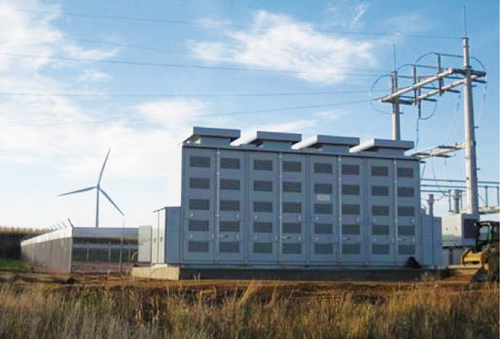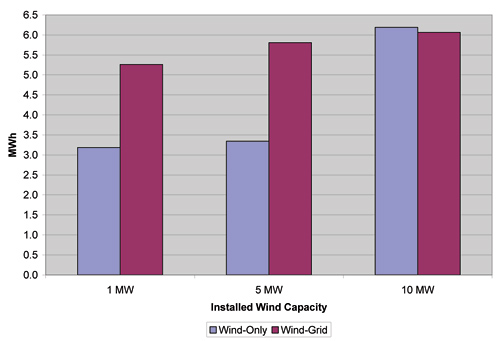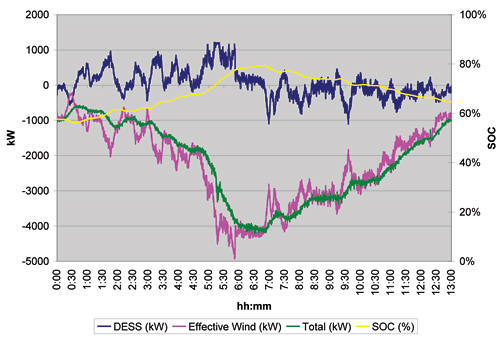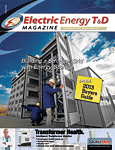Energy storage technologies can help electric utilities increase grid efficiency, capacity, and reliability by supplementing power generation, supporting transmission and distribution systems, and meeting the evolving needs of energy consumers. While best known for its ability to facilitate integration of renewable resources into the grid by managing intermittency, energy storage can serve many purposes. And, in its diverse forms, storage is proving itself essential to building a smarter, more responsive grid.
From stationary large-scale batteries and flywheel plants to compressed air energy storage (CAES) and distributed systems such as community energy storage (CES), development and deployment of storage is accelerating. While a key driver of this movement remains the proliferation of distributed renewables, the current and future applications of storage reach beyond the collection, buffering, and dispatch of wind, concentrated solar, tidal power, and other variable “green” resources.
From generation and transmission to distribution and consumption, energy storage can play a vital role in nearly every facet of the Smart Grid, driving its evolution. The benefits of storage are broad and deep. It can reduce wear-and-tear and reliance on traditional generators and other grid assets, and lower peaking costs. Storage can supply ancillary services, such as fast-response frequency regulation, short bursts of power that stabilize the grid. For distribution systems, storage can rapidly regulate voltage levels, provide economical peak load shaving and substation load leveling, and help utilities defer or eliminate more costly system upgrades. For residential and commercial consumers, storage provides reliable backup power, enhances power quality, and manages peaks without requiring demand reduction.
Still in its infancy, grid-purposed energy storage holds tremendous potential to fortify and transform our electric infrastructure, a fact that’s reinforced as more projects demonstrate groundbreaking results.
Grid-Tied Wind Energy Storage System Delivers on Its Promise
Battery-based energy storage has not yet been widely deployed on the grid. Up-front costs have been a significant barrier, making it challenging for utilities to justify deployment. And, until very recently, large-scale projects demonstrating the vast benefits battery storage can bring to the grid have not been readily undertaken. Questions about what storage can do to integrate renewable generation have been largely theoretical. Xcel Energy® undertook a significant research project in order to answer the questions of “how much” and “what are the benefits,” so that the electric power industry can justify investments in grid-tied battery storage and begin realizing its enormous potential for renewables integration and dispatch and other key goals.
A major U.S. electric and natural gas utility operating in eight states, Xcel is the nation’s premier utility wind power provider and fifth largest solar energy supplier. Based in Minneapolis, Xcel is demonstrating unparalleled leadership in leveraging renewables and grid-scale storage systems for a cleaner energy future. In fact, Xcel’s “Wind-to-Battery” project, initiated in 2009, is proving just how ideally suited battery storage is for making distributed renewable generation much less variable and much more dispatchable—critical benefits due to the proliferation of distributed renewables in the U.S. and globally.
Despite wind’s variability and dispatch issues, the project has demonstrated that the amount of power and energy needed to allow a wind plant to work more compatibly with the grid is relatively modest. For roughly 20 to 40% of a wind plant’s nameplate power rating and just 2 to 6 hours of battery storage, utilities can quickly realize most of the benefits energy storage has to offer in today’s market.
Xcel’s project set out to evaluate the effectiveness of a 1-MW (7.2-MWh) sodium-sulfur (NaS) battery-based system for integrating wind energy into the grid. They tested the system’s core capabilities, which included time-shifting energy, wind smoothing, and dispatched wind leveling. They also evaluated battery storage for grid frequency regulation services. Xcel chose NaS storage because of its superior energy density and storage capacity, ability to withstand large numbers of charge-discharge cycles, dynamic operation, and large-scale deployment potential. Fully charged, this battery could power 500 homes for more than seven hours.
Xcel’s system consisted of S&C Electric Company’s PureWave® Storage Management System (SMS) connected to NGK Insulators’ NaS battery and the 11.5-MW MinWind Energy LLC wind plant in Luverne, Minnesota. These elements comprised the standalone power conversion system, which was installed by S&C at a new substation near the Xcel and MinWind substations. MinWind’s plant connects to a 34.5-kV power grid. The system includes interfaces for the wind plant and the grid; emergency backup power to regulate battery temperature; and components for local and remote performance monitoring, data collection, system control, and other communications. A variable scale factor allowed the system to operate as if connected to a 10-MW, 5-MW, or 1-MW wind plant, so that different generation-to-storage ratios could be explored.

Xcel Energy’s Groundbreaking “Wind-to-Battery” Storage Project
This large-scale battery storage system captures wind energy and dispatches it to the electric grid
as needed. It also reduces the impacts of wind variability and unpredictability and provides frequency
regulation to stabilize the grid.
Source: Xcel Energy
The first domestic application of the NaS battery as a direct wind energy storage device, this project thoroughly examined the system’s ability to time-shift wind energy from off-peak to on-peak availability, smooth wind variability (ramp rate control), limit deviations between actual and scheduled wind output (wind leveling), and follow frequency regulation signals as a generator and a load. This landmark project allowed the grid-tied battery system to operate as a traditional power plant, including selling its stored wind energy on the Midwest Independent System Operator (MISO) market and responding to internal Automatic Generation Control signals to supply frequency regulation services that stabilize the grid.
Due to the limitations of existing renewable energy integration methods and Xcel’s expectations of high renewable penetration into their operating systems, the results of their Wind-to-Battery storage project were pivotal. Xcel’s extensive testing of their battery-based system yielded positive performance results in all modes of operation, including basic generation storage, wind smoothing, dispatched wind leveling, and frequency regulation. All modes of operation provided dynamic voltage regulation. Final results became available in December 2011.
Generation Storage Scenarios and Results
The system was tested to explore charging due to wind only and wind plus grid storage. Charging times were fixed at 8.5 hours with 4 hours allowed for grid charging. Xcel scheduled the NaS battery to discharge during set peak periods and recharge during set off-peak periods at a rate proportional to and coinciding with MinWind’s power output. The system performed as expected over a six-week test period, during which data was collected at one-minute intervals. A 1-MW battery connected to a 5-MW wind plant yielded the best results, and it was concluded that an optimal ratio of plant-to-storage was between 5:1 and 10:1. To allow full battery charging from only the wind plant itself most of the time, the optimal point is probably closer to 30% of plant power rating with an energy capacity of 2 to 6 hours.

Applying Wind Power Generation to Battery Storage
Average MWhrs of effective system charging (6 MWhrs is fully charged) for a 1-MW battery applied to various-sized
wind plants. Average system charge energy is provided for both wind-only and wind-grid charging options; optimal ratio
of wind plant-to-storage falls between 5:1 and 10:1 for this wind resource.
Source: Xcel Energy
Wind Smoothing (Ramp Rate Control) Results
To reduce wind power variability, the PureWave® SMS was programmed to counter increases and decreases in power output, mitigating the wind plant’s naturally high ramp rates. This approach gives system operators more time to respond to power output changes, enabling more strategic dispatch decisions and increasing grid reliability.
Xcel tested the system in wind smoothing mode for 18 days in different scenarios (with 1-MW, 5-MW, and 10-MW plant capacities) for 20, 40, and 60 minutes. Each configuration was tested for two days, with data collected at 10-second intervals. For all configurations, the system smoothed wind output as expected for the majority of the time. For example, during the 20-minute 5-MW test, the system effectively limited the ramp rates for most events. During the 1-MW test, it successfully limited the rate of change for all ramping events.
Xcel Energy’s Wind-to-Battery Project
By Frank Novachek, Xcel Energy Director of Corporate Planning
As the nation’s No. 1 wind power provider and No. 5 solar energy provider, Xcel Energy has demonstrated its renewable energy leadership in the utility industry. We continue to pursue wind and other types of renewable generation technologies in line with a strategic vision of a clean energy future.
However, as more wind capacity comes on line and meets a greater amount of our customers’ needs, system impacts will become inconsequential and have to be addressed. With a large penetration of wind already in our portfolio, Xcel Energy is seeking innovative ways to integrate renewable energy. One potential solution is large-scale electrochemical energy storage, which we demonstrated with our 1 megawatt, 7 megawatt-hour sodium sulphur (NaS) battery system in Luverne, Minnesota.
By supporting the wind-to-battery energy storage demonstration project, Xcel Energy, the project’s funders, and customers have benefitted in a number of ways.
We have gained a better understanding of the advantages flexible energy storage may have over traditional natural gas peaking resources once energy storage prices become competitive with those of traditional peaking resources because flexible energy storage is both a dispatchable load and a dispatchable generator. Our improved expertise in identifying the essential storage functions that are of value to the grid and its utility customers will ultimately result in better service at lower costs.
We also better understand how to determine the price range for energy storage deployments that will be cost effective for our customers, and we are using that information to provide input to the energy storage industry.
Now that the testing is complete, the actual commercial use of the battery energy storage system will be providing fast-response, ancillary services to the Midwest Independent Transmission System Operator.
The potential for affordable energy storage systems in the next five to ten years is real, and because of this demonstration and associated analyses, Xcel Energy is in a much better position to know when it will be right for our customers.

Novachek with Xcel Energy’s one-megawatt
NaS battery system, which integrates wind
energy into the grid.
Source: Xcel Energy
Frank Novachek has more than 30 years of diverse experience with the company. Now based in Denver, Col., Frank’s focus and leadership on the R&D of plans and strategies around energy storage, is crucial to growing Xcel’s current status. He holds a bachelor’s degree in physics from Colorado State University and an MBA from the University of Colorado.
These results demonstrate the effectiveness of energy storage in mitigating wind intermittency. Additional investigation determined the optimal storage-to-wind ratio for generation shifting to be suitable for limiting wind generation ramp rates too, and that both tasks could be coupled to maximize system benefits.

(click to enlarge)
Wind Smoothing (Ramp Rate Control)
Results for a 1-MW battery connected to a 5-MW wind plant over
13 hours, with a time constant of 20 minutes and a scaling factor
of 43.3%. DESS is the system (SMS); SOC is the state of charge.
Source: Xcel Energy
Wind Leveling (Dispatched Wind) Results
Predicting and scheduling wind power output is problematic by nature. MISO’s “day ahead” requirement means wind plant operators must predict output 14 to 38 hours in advance in order to sell wind energy on that market. Using the battery-based system in wind leveling mode over six separate days for 5.5-hour to 8.4-hour periods, Xcel consistently reduced the uncertainty of their wind plant power output. For all tests, they collected data at one-minute intervals and updated the combined power set-point every 30 minutes.
Whenever actual wind power output deviated from the scheduled output value, the battery charged or discharged energy to compensate for the difference. This charge-discharge method enabled Xcel to achieve steady output control for all scenarios
(1-MW, 5-MW, and 10-MW), as expected. The 1 MW battery system effectively leveled 1-MW of installed wind capacity. Optimal results were achieved with a 5-MW wind plant.
In all cases, the battery responded swiftly and precisely to plant power output changes, providing highly effective dispatched wind leveling. These results support the use of energy storage to improve wind plant operations and economics.
Frequency Regulation Results
In addition to tests focused on wind energy, Xcel evaluated the use of their large-scale battery storage system to provide grid ancillary services, both as a load and as a generator, to the MISO market. The system followed a frequency regulation signal that Xcel generated based on changes in the Area Control Error (ACE) for MISO.
Frequency regulation stabilizes the electric grid by helping generation-load balancing authorities maintain ACE within limits set by the North American Electric Reliability Corporation (NERC) control performance standards.
Frequency regulation testing was conducted for six 24-hour periods using two different ACE dead-band ranges, each for three days. The system’s NaS battery performed very well, responding rapidly and accurately at control set-points. It demonstrated excellent, continuous ramping capabilities, following fast-changing set-points issued by Xcel’s Northern States Power (NSP) Energy Management System. The battery never exceeded one 7.2-MWh discharge cycle per day (averaged 0.81 cycles over two test variations). Further investigation of economics involved simulations of selling this particular battery system’s power into MISO’s current ancillary services market and confirmed significant potential for delivering quality frequency regulation services and contributing to profitability.
The Expanding Role of Energy Storage
Working in close collaboration with S&C and NGK, Xcel Energy successfully demonstrated the diverse performance and economic benefits of energy storage through its “Wind-to-Battery” initiative, which helps provide a roadmap for a smarter, greener, and more adaptable grid. Based on the project’s groundbreaking results, it’s clear that the benefits of grid-tied storage, and specifically battery-based storage, can more than justify up-front investments (when 4 to 6 hour energy storage systems become cost-competitive with traditional gas-fired resources) for use with renewables and beyond. A fairly modest amount of battery storage can make wind farms and other renewable plants a much better fit for our grid today. Broader scale storage deployment over time will undoubtedly continue to reinforce this fact.
While energy storage has been proven to address renewables integration and intermittency, and can be dispatched effectively, its role is rapidly expanding. Storage supports a growing array of applications not exclusively linked to renewables, such as grid frequency regulation, reliable local backup power, microgrids and dynamic islanding, and multiple aspects of power quality. At the same time, more applications are emerging, including new and reinvented forms of electrochemical technologies for larger-scale grid storage and “distributed bulk” storage, additional storage-based grid ancillary services such as “black start” for service restoration, and even bundled energy storage solutions for the grid.
Another innovative new application is Community Energy Storage, a Lithium-Ion battery-based system that meets the need for storage at the grid’s edge. Small pad-mounted units, CES systems offer many of the same benefits as larger storage devices, but they can be easily distributed along residential feeders. During grid outages, a standard 25-kVA CES unit, such as S&C’s PureWave® Community Energy Storage System, can provide reliable backup power to multiple homes for 1 to 3 hours. Utilities can aggregate the functionality of up to 1,000 grid-tied CES units with S&C’s IntelliTeam® DEM Distributed Energy Management System. The DEM allows units to act collectively as a single scalable energy storage plant and improve power quality, increase voltage control across feeders, increase efficiency through power factor correction, and provide asset relief through peak shaving, allowing utilities to defer distribution system build-outs. CES batteries can also integrate and buffer residential-scale renewable resources, and recharge from the grid during off-peak hours, a functionality that Xcel Energy (partnering with S&C and FIAMM Group) will begin testing later this year at the SolarTAC facility in Aurora, Colorado. By leveraging CES fleets, utilities can help make our power infrastructure more reliable, efficient, and intelligent.
Energy storage, when widely and strategically deployed in its diverse forms, provides a green alternative and complement to traditional resources. For instance, when storage supplies the grid with frequency regulation services, the need for inefficient fossil-fuel-based generation resources is reduced or eliminated. Energy storage can also address an array of power quality issues—from increasing system reliability by reducing power losses to improving demand-side management by meeting peak demand—as well as renewables integration and ancillary services, all of which directly impact our aging infrastructure. These issues will continue to be compounded by increased integration of renewable generation far into the future, making storage essential. As peak loads grow and more variable resources come online, energy storage is certain to play a pivotal and indispensable role in balancing and stabilizing sources and loads, which means a stronger grid is on the horizon.
About the Author
 Jim joined S&C Electric Company in 2003 and is currently Vice President of Power Quality Products in Milwaukee, Wisconsin. During his tenure, his division’s PureWave® Storage Management System has been selected for many significant distributed storage projects conducted in the last few years in the U.S. Working with the nation’s largest utility company, S&C has provided turnkey product and service solutions for four Sodium-Sulfur (NaS) battery projects totaling 7.0 MW (43 MWh) through the end of 2008. The PureWave® SMS has been deployed in 19 projects totaling 30 MW with four different battery technologies. The projects were designed to expand the use of distributed energy storage throughout the grid to incorporate system reliability improvements, islanding, and ancillary service support.
Jim joined S&C Electric Company in 2003 and is currently Vice President of Power Quality Products in Milwaukee, Wisconsin. During his tenure, his division’s PureWave® Storage Management System has been selected for many significant distributed storage projects conducted in the last few years in the U.S. Working with the nation’s largest utility company, S&C has provided turnkey product and service solutions for four Sodium-Sulfur (NaS) battery projects totaling 7.0 MW (43 MWh) through the end of 2008. The PureWave® SMS has been deployed in 19 projects totaling 30 MW with four different battery technologies. The projects were designed to expand the use of distributed energy storage throughout the grid to incorporate system reliability improvements, islanding, and ancillary service support.
Jim holds 8 U.S. patents and is an IEEE member. Jim received a BSEE degree from Cornell University in 1979 and an MBA from the University of Wisconsin, Milwaukee in 2002.







